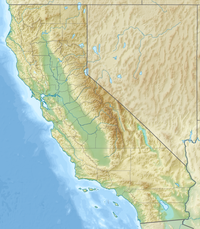Half Dome
| Half Dome | |
|---|---|

Sunset over Half Dome from Glacier Point
|
|
| Highest point | |
| Elevation | 8844+ ft (2695+ m) NAVD 88 |
| Prominence | 1,360 ft (410 m) |
| Parent peak | Clouds Rest |
| Coordinates | 37°44′46″N 119°31′59″W / 37.7460363°N 119.5329397°WCoordinates: 37°44′46″N 119°31′59″W / 37.7460363°N 119.5329397°W |
| Geography | |
| Parent range | Sierra Nevada |
| Topo map | USGS Half Dome |
| Geology | |
| Age of rock | Cretaceous, 93 Myr |
| Mountain type | Granite dome |
| Climbing | |
| First ascent | 1875 by George G. Anderson |
| Easiest route | Cable route |
Half Dome is a granite dome at the eastern end of Yosemite Valley in Yosemite National Park, California. It is a well-known rock formation in the park, named for its distinct shape. One side is a sheer face while the other three sides are smooth and round, making it appear like a dome cut in half. The granite crest rises more than 4,737 ft (1,444 m) above the valley floor.
The impression from the valley floor that this is a round dome that has lost its northwest half is an illusion. From Washburn Point, Half Dome can be seen as a thin ridge of rock, an arête, that is oriented northeast-southwest, with its southeast side almost as steep as its northwest side except for the very top. Although the trend of this ridge, as well as that of Tenaya Canyon, is probably controlled by master joints, 80 percent of the northwest "half" of the original dome may well still be there.
On March 28, 2009, a large rock slide of 1,500,000 cubic feet (42,000 m3) occurred from Ahwiyah Point. The slide happened at 5:25 a.m. and damaged a large area under the dome. No one was injured, but hundreds of trees were knocked down, and a portion of the Mirror Lake trail was buried. The slide registered on seismographs as an earthquake reaching 2.5 on the Richter Scale.
As late as the 1870s, Half Dome was described as "perfectly inaccessible" by Josiah Whitney of the California Geological Survey. The summit was finally conquered by George G. Anderson in October 1875, via a route constructed by drilling and placing iron eyebolts into the smooth granite.
Today, Half Dome may now be ascended in several different ways. Thousands of hikers reach the top each year by following an 8.5 mi (13.7 km) trail from the valley floor. After a rigorous 2 mi (3.2 km) approach, including several hundred feet of granite stairs, the final pitch up the peak's steep but somewhat rounded east face is ascended with the aid of a pair of post-mounted braided steel cables originally constructed close to the Anderson route in 1919.
...
Wikipedia

